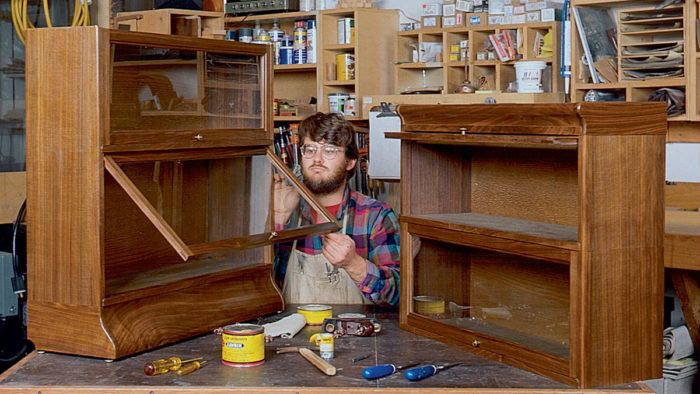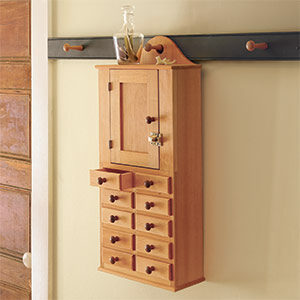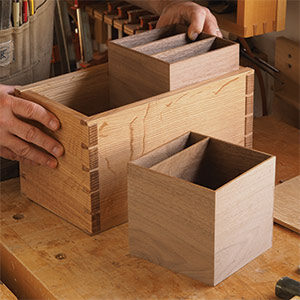How to Build a Barrister’s Bookcase
Stackable cases with retractable overhead doors
Synopsis: Jeff Greef rebuilt a barrister bookcase from the early 1900s after it was damaged in an earthquake, and what he learned about it inspired him to build his own very much like it. Greef’s design consists of a couple of carcase modules, stacked together with a base and top unit. It has retractable doors that use pulleys so the doors don’t pull askew when opened. Greef explains how he chose materials and put the cases together, how he made the parallel mechanism, and final assembly. Detailed project plans illustrate the construction of the cases and pulley system, and a side article by Alec Waters details the guides that align overhead doors.
Among the victims of California’s 1989 Loma Prieta earthquake was a sectional bookcase (also known as a lawyer’s or barrister’s bookcase) belonging to a friend of mine. When she asked me to rebuild it, I inspected the parts she had laid in her garage. Damage was minimal, mostly disassembled joints rather than broken wood, so repairs would be easy. The bookcase was composed of separate cases stacked together and aligned by tongues, grooves, dowels and holes. There were also pedestal and crown units that attached to the bottom and top of the assembled cases. Each shelf module had a glazed door, which pivoted at its top, then slid into a pocket above the opening.
I also saw something that mystified me—a curious system of metal bands, wooden channels, and small wooden pulleys, around which the bands were wrapped. Closer investigation revealed that the purpose of the mechanism was to guide the doors, so they would slide parallel to the case sides and not turn askew and bind with the carcase when opened. I was so intrigued by the guide system on this 80- year-old set, I resolved to build a stacking bookcase with a similar wood and metal mechanism for myself.
The refurbished bookcase, labeled “The Viking,” was patented and built by Skandia Furniture Co. of Rockford, Ill. Patent dates on the label, and the owner’s recollection, put the time of the case’s manufacture around 1906.1 was disappointed at first to see the basic construction for the carcase modules was rabbets and nails. But practical experience contradicted my negative judgment—all the nailed joints survived the thrashing of the earthquake, whereas half the hide-glued joints broke. After reconsidering, I decided to use the same construction as Skandia with only minor changes. I broke the project down into four assemblies: top and bottom units, carcases, doors and parallel mechanisms.
Materials and case construction
All visible wood on the Skandia cabinet was darkly stained oak, and all the unexposed parts were made from either poplar or alder. For my case, I used air-dried California black walnut for the primary wood and poplar for the secondary wood. I edge-glued walnut to poplar for the cabinet bottoms (bookshelves) and for the rear rail of the top unit. Instead of gluing up the carcase sides, which had cupped on the oak original, I used single pieces of quartersawn walnut.
From Fine Woodworking #96
For the full article, download the PDF below:
Fine Woodworking Recommended Products

Bessey EKH Trigger Clamps

Festool DF 500 Q-Set Domino Joiner

Starrett 12-in. combination square






















Log in or create an account to post a comment.
Sign up Log in